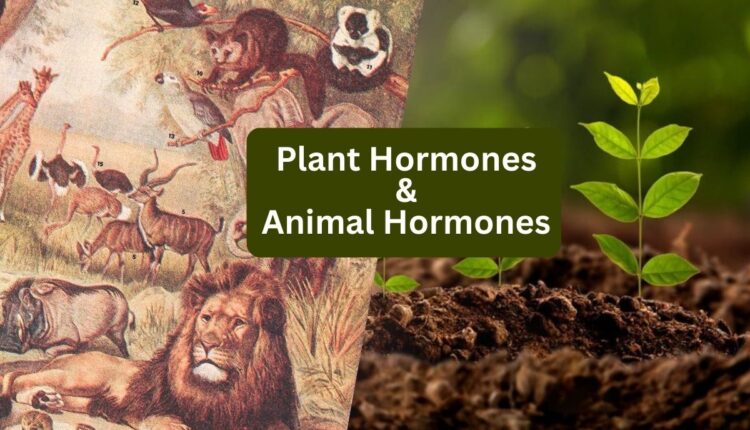Plant Hormones and Animal Hormones: A Comparative Analysis
We can find several striking similarities between plant hormones and animals hormones
Both plants hormones and humans have hormones that play crucial roles in growth and development. In plants, the main classes of hormones include auxins, cytokinins, gibberellins, abscisic acid, ethylene, and brassinosteroids. Similarly, animals have hormones such as insulin, estrogen, testosterone, growth hormone, etc. Hormones in both plants and animals act as chemical messengers, coordinating various physiological processes and ensuring proper growth and development.
Similarities between plant hormones and animal hormones
Plant hormones and animal hormones exhibit similarities in terms of their chemical structure, signal transduction, regulation of growth and development, response to environmental stimuli, transport and distribution, as well as feedback regulation. Despite their differences in specific structures and functions, both types of hormones serve as vital regulators for their respective organisms. Understanding these similarities can provide insights into the fundamental principles of hormone signaling and the importance of hormonal regulation in maintaining the proper functioning of plants and animals. Further research on the similarities and differences between plant hormones and animal hormones can contribute to advancements in fields such as agriculture, medicine, and ecology, benefiting both human and environmental health.
A comparative analysis
Here are some specific similarities
- Chemical Structure: Both plant hormones and animal hormones are organic compounds. They are typically small molecules that are synthesized within the cells of the organisms. Although the specific chemical structures differ, they share similarities in terms of their basic structure and functional groups.
- Signal Transduction: Both plant hormones and animal hormones transmit signals to target cells or tissues by binding to specific receptors. These receptors are typically present on the surface or within the cytoplasm of target cells. Once hormone-receptor binding occurs, it triggers a cascade of intracellular events that eventually leads to a specific physiological response.
- Regulation of Growth and Development: They play a crucial role in regulating growth and development processes. They control cell division, differentiation, and elongation, ultimately influencing the overall development and morphology of the organism. For example, auxins in plants promote elongation of cells, while growth hormone in animals promotes bone and muscle growth.
- Responses to Environmental Stimuli: Both facilitate responses to various external and internal stimuli. They enable the organisms to adapt to changes in light, temperature, humidity, nutrient availability, and other environmental factors. For instance, ethylene in plants triggers fruit ripening in response to changes in the surrounding environment, while cortisol in animals helps regulate stress response.
- Transport and Distribution: Both are synthesized in specific locations within the organism but are often required to exert their effects at distant sites. For this reason, they need to be transported from the site of synthesis to the target tissues. Plant hormones are typically transported within the vascular system, while animal hormones may be transported through the bloodstream or other specialized transport systems.
- Feedback Regulation: Hormonal systems in both plants and animals are regulated by feedback mechanisms. This ensures that hormone concentrations are maintained within an optimal range. Excessive or insufficient hormone levels can have detrimental effects on the organism’s growth and development. Negative feedback loops are commonly involved in hormone regulation to achieve homeostasis.
Tabular comparison on the basis of hormones
Furthermore, both plant and human hormones respond to environmental cues and help organisms adapt to changing conditions. Abscisic acid in plants regulates responses to drought and stress, while ethylene is involved in fruit ripening and senescence. In humans, hormones like cortisol help regulate responses to stress, while estrogen plays a role in the menstrual cycle and pregnancy. These hormonal responses to environmental factors highlight the adaptive nature of plants and humans, ensuring survival and reproductive success.
| Hormone | Plants | Animals |
| Auxin | Promotes cell elongation, | Controls cell growth and |
| root initiation, and | differentiation, regulates | |
| lateral branching in plants | development, and coordinates | |
| various physiological processes | ||
| Gibberellins | Promotes stem elongation, | Regulates growth, enhances |
| seed germination, and fruit | fruit development, and | |
| development in plants | influences various developmental | |
| processes | ||
| Cytokinin | Stimulates cell division and | Regulates cell division and |
| differentiation in plant | differentiation, influences | |
| meristems, promotes plant | various aspects of animal | |
| growth in tissue culture | development and homeostasis | |
| Abscisic acid | Inhibits growth, closes stomata, | Regulates various physiological |
| and promotes seed dormancy | processes such as seed dormancy, | |
| and drought tolerance in plants | stress responses, and stomatal | |
| closure | ||
| Ethylene | Regulates fruit ripening, | Controls various aspects of |
| abscission, and senescence, | development, growth, and | |
| promotes root growth and | responses to stress and | |
| inhibits stem elongation in | environmental stimuli | |
| plants | ||
| Insulin | Absorbs glucose from blood, | Regulates blood glucose levels, |
| promotes glucose storage in | promotes glucose uptake by cells, | |
| plants | and influences various metabolic | |
| processes |
The Intricate World of Hormones
Finally, both plants and humans exhibit hormonal interactions and feedback mechanisms. In plants, hormones can have synergistic, antagonistic, or complementary interactions, allowing for precise control of growth and development. Similarly, human hormones can interact with each other, often through feedback loops, ensuring proper hormonal balance and regulation. These interactions and feedback mechanisms maintain homeostasis and keep the organism functioning optimally.
These similarities highlight the fundamental principles of hormone regulation and emphasize the shared evolutionary origins of these complex biological systems. By understanding and appreciating these similarities, we can gain a deeper insight into the intricate and fascinating world of hormones in both plants and humans.
Also Read: Smart Nitrogen Management Is The Key To Successful Agriculture
Contact us – If farmers want to share any valuable information or experiences related to farming, they can connect with us via phone or WhatsApp at 9599273766 or you can write to us at “[email protected]”. Through Kisan of India, we will convey your message to the people, because we believe that if the farmers are advanced then the country is happy.
You can connect with Kisan of India on Facebook, Twitter, and WhatsApp and Subscribe to our YouTube channel.



